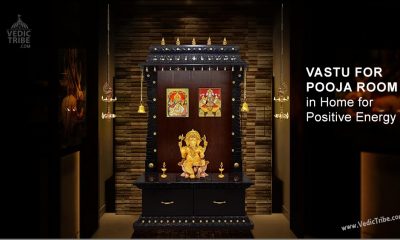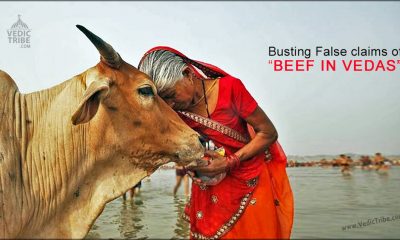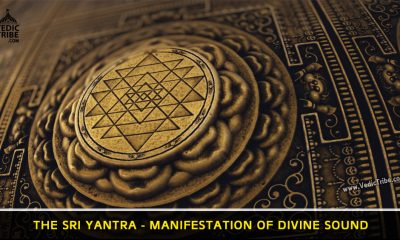Vedic Science
Vedic Science – Benefits of Eating With Your Hands
Published
5 years agoon
By
Vedic Tribe
~Bri. Maya Tiwari
In Vedic tradition, we eat with our hands because the five elements within them begin to transform food and make it digestible even before it reaches the mouth. This transformation also heightens the senses so that we can smell, taste and feel the texture of the foods we are eating. We can also hear the sounds of eating. All of these sensations are a necessary prelude to beckoning agni, the fire of digestion, to ready itself for the meal to come.
Hands are considered our most precious organ of action. Our hands and feet are said to be the conduits of the five elements–space, air, fire, water and earth. One of the five elements courses through each finger. Through the thumb, angushtha, comes space; through the forefinger, tarjani, air; through the midfinger, madhyama, fire; through the ring finger, anamika, water and through the little finger, kanishtha, earth.
On the greater dimension, the act of eating is spiritual feasting. We are activating the energies of the Deities aligned with the elements, stimulating a surge of heightened consciousness within. This is made possible through the powerful play of mudra. It brings the elements of nature through our hands and fingers into the food, and then joins it with agni. If we are aware of awakening the fire within ourselves, we digest not only the food but also our thoughts more smoothly. The fire of digestion and the fire of the mind, tejas, work hand-in-hand. As you see below, there are six specific mudras for eating.
Ayurveda tells us that disease takes rise in the body because the digestive fire is awry and the mind is agitated. Most people today eat and run, juggling an overly full calendar. We often skip breakfast, eat a less-than-nutritious lunch, and that too in a hurry, and sit down to dinner late at night, after which we immediately fall into bed. How could proper digestion occur when we force the system to put up with such abuse year after year? In this frantic pace of living, how could we maintain composure in the mind and therefore remember the sacred purpose of these limbs? No wonder then that we have such a high incidence of cancer and heart disease, and ailments resulting from improper diet. We refuse to observe the integrity of our physiology by nourishing our bodies and souls with dignity and respect. Using the time-honored ways of sadhana can help us to restore health and harmony in our everyday lives.

Eating food with your hands feeds body, mind and spirit. According to the Taittiriya Upanishad, food represents the coarsest and last of the five vestures in which the soul is clothed and passes from body to body in the long process of metempsychosis. In other words, food is not limited to what we eat, but expresses the universe’s entire body and all that is manifested within her. Likewise, we eat food not only to sustain the body, but to assimilate the universe’s elements and energies within our physical and emotional body and to nourish the greater, spiritual Self. The Taittiriya Upanishad tells us: “The essence of all things here is the Earth. The essence of Earth is water. The essence of water is the plant. The essence of the plant is a person.”
Let’s take this text a step further and ask ourselves: what is the essence of a person? I believe it is the fundamental nature that is uniquely ours and connects us to the universe. As humans, we are linked to the vast energy of the infinite, dimensionless universe by way of our limbs. The Purusha Suktam, a sixteen-mantra poem composed by the sage Narayana is regarded as the oldest work on cosmic anatomy and ecology. It reveals that the universe is an infinite continuum of energy. Yet it describes this energy as a living force, with eyes, ears, arms, legs, hands and feet and heads watching over all of existence. Just as the universe guards the many limbs and energies of its infinite structure, so each of us is meant to become aware of the greater life force and its many aspects. The sage explained that the individual who strives to live a spiritual life must first be aware of the life force and its many manifestations, limbs and faces before he can accomplish and serve it.
When we use our limbs in accord with the sacred laws of nature, every action worships and praises the omniscient Divinity in all things. When we eat with our hands, or feed the young and infirm with them, use them to dig into the rich soil and plant a good seed, embrace someone, or give them a gift, clasp the hands in prayer, we are using our hands to share in the maternal healing energies of the universe. Being conscious of how we use our hands is a wonderful act of sadhana.
To remind yourself each day of the sanctity of your limbs, recite the Vedic prayer, “Karagre vasate Laksmih karamule Sarasvati Karamadhye tu Govindah prabhate karadarsanam,” which means, “On the tips of my fingers is Goddess Laksmi, on the base of my fingers is Goddess Sarasvati, in the middle of my fingers is Lord Govinda. In this manner, I look at my hands.”
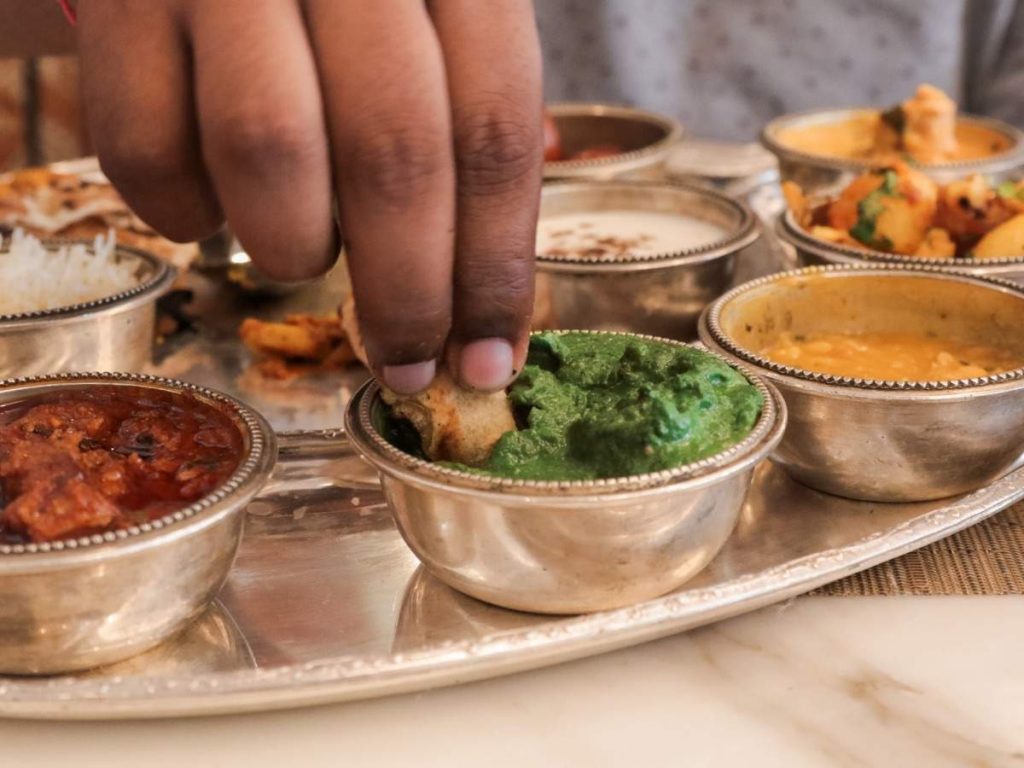
To start your mudra practice, engage anjali mudra. Each morning you engage this practice will help you remember the sanctity of your hands and your connection to the creative energies of our universe. In anjali mudra, bring the palms of your hands together in front of the heart, with fingers pointing upward. When we clasp the hands in this manner, we stimulate the prana, or energy, that circulates through the heart, which increases its vitality and brings us a sense of ease and resolve. To evoke the Deities, raise the clasped hands to the center of the forehead. This mudra is itself an act of prayer and helps to heal the heart, not only of the trespasses of the present life, but also of the wounds incurred through timeless rebirths. When you bring your hands together, you are transforming all five elements back into their source of tejas, the energy of the subtle fire of creation that is responsible for cellular and nuclear metabolism within and without. You will immediately feel oneness with the Divine.
We are all embarked on a lifelong quest for consciousness, which emerges from the cultivation of awareness, the inner knowing that depends entirely on the harmonious relationship we develop with nature. The aim of the food sadhana practices I advocate is to help us reconnect to the greater energy of the universe so that we may restore our cognitive memory that goes far back to the origin of the universe. Using mudras for eating and communing with the food we eat is a paramount step to connecting with cosmic energies and a vital means of receiving nourishment by touching upon the Earth’s bounty. The practice of these specific mudras is likely to open your heart to the Mother’s wisdom. Feast with your hands at Her table and you will never go hungry or angry. Food is memory. Eating with your hands is remembering your sacred nature.
While in the West eating with the hands usually conjures up pictures of a young child smeared from head to foot with food, in the East, using the hands as utensils is a highly refined art. Here are the six major ways in which the hands are used.:
Ghronikah mudra
In ghronikah mudra the five fingertips form a petal around a lump of food about the size of a plum. This is one of the two main mudras used for eating solid food like grains and vegetables, or for scooping daals with chapati or bread.
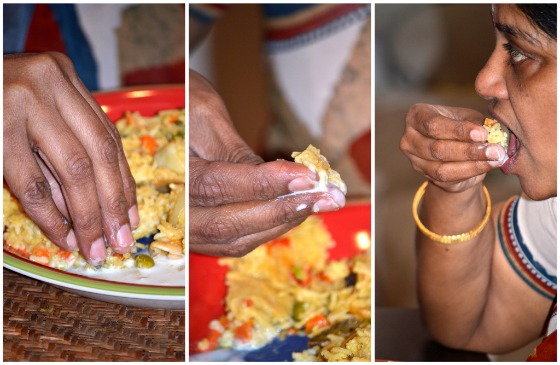
Annabhakshana mudra
In annabhakshana mudra, use the fingertips to pick up a small amount of food, sufficient to fit on the base of the four fingers. Use the thumb to advance the food forward and into the mouth. This is the second of the two main mudras for eating any solid food. Only the right hand is used for eating. Annabhakshana mudra practice cultivates our discrimination in eating good quality food in the appropriate quantity and in a tranquil environment.
Kangulah mudra
Kangulah mudra is taking food with the thumb, forefinger and mid-finger. Engage this mudra when eating long, slender pieces of food, like asparagus, carrots, celery, sugar cane and “drumsticks” or murungai. As we bring food to our mouth in kangulah mudra, the palm of the hand faces upward, evoking the spirit of consciousness as we touch upon Nature. This mudra cultivates a gentle reverence for Nature’s precious gifts. The first mudra, Ghronikah, activates and balances the element of earth within the body. The earth element controls our sense of smell and gives us added vision to “smell our way,” that is, to be keenly aware of our connection to Mother Nature.
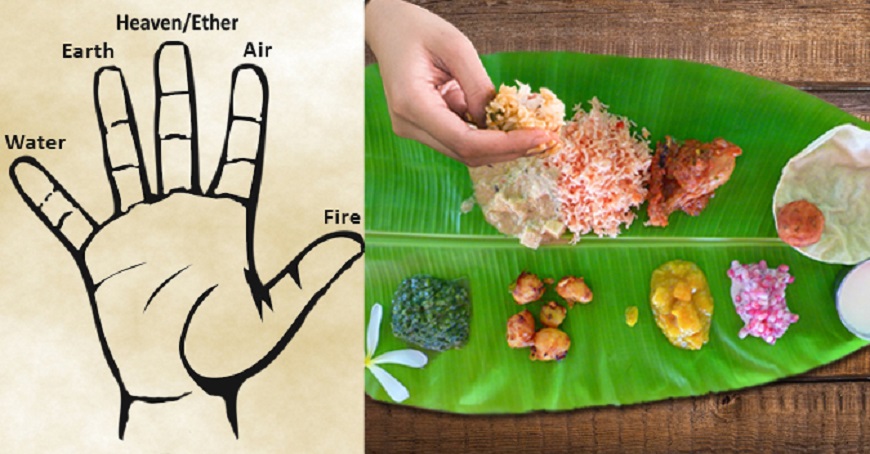
Kadambah mudra
Kadambah mudra crouches the five fingers around firm, solid food. This mudra is reserved for eating round-shaped fresh fruits that fit neatly in the palm of the hand, such as apple, pear, mango or peach. You may also use it to eat sweets like ladhu. The mudra is named after the famed kadamba tree, which is said to put forth buds at the roaring of thunder-clouds, and which produces hard, inedible fruits. When Mother Nature is mistreated and taken for granted, she roars her thunder and makes rare her fruits. Practicing this mudra helps us to remember to be grateful for every speck of Nature’s food.
Mukulah mudra
Mukulah mudra is eating with all five fingers tightly knitted together. In this mudra a minimal quantity of food is taken at a time, for example, ten grains of cooked rice. The mudra is used in annaprashanam, or the ceremony of first feeding, one of the 16 samskaras, usually performed in the fifth or sixth month of a child’s life. Mukulah mudra is a reminder that we are forever in the bud of life, continually regenerating the on-rushing flow of awareness. Every bite of food must serve to awaken cosmic memory of the first food we, as conscious human beings, imbibe from the Mother’s nectary.
Khatakamukhah mudra
Khatakamukhah mudra is tasting or sampling food with forefinger, mid-finger and thumb tightly pinched. This mudra measures the equivalent of a half-teaspoon. It is used to mete out spices and condiments in cooking. We may also use it as a pinch-measure for medicines. Food is the most potent form of medicine. We need to exercise caution. Keeping our hearts open but our hands half-closed when receiving food is a good policy to maintain. Khatakamukhah mudra helps us to exercise firm discretion around food.
You may like

Vastu Shastra (or short just Vastu) is the Indian science of space and architecture and how we may create spaces and environment that supports physical & spiritual health and prosperity.
Vastu Shastra evolved during Vedic times in India. The concept of Vastu Shastra was transferred to Tibet, South East Asia and finally to China and Japan where it provided the base for the development of what is now known as Feng Shui.
Vastu Shastra is the art and science of designing houses, offices, temples etc that swirl with good energy. Indian Maharajas and Moghul Emperors used Vastu Shastra when they built their symmetrical palaces, artificial lakes, and geometric courtyards that thirstily absorbed positive energy.
Like feng shui, Vastu Shastra is based on an octagon with the four directions being the anchors. Hindus believe that gods live in each of the quarters of the house, and govern the rooms, possessions, and activities in these locations.
Vasthu is an inherent energy concept of science. We cannot see energy with our naked eyes but we can realize and see its application in different forms and fashions. Vastu Shastra uses the forces of natural energies and aims to restore the balance between the home (the microcosm) and the cosmos (the macrocosm).
Vastu Shastra is not only a science, but is a bridge between man and nature, thus teaching us the Art of Living. Just like every subject of human aspect is governed with rules, regulations and acts, similarly the nature has also got certain key factor principles for smooth governing of its residents, in which Vastu Shastra stands for the law of natural energies.
Vastu, which literally means to live, works on the premise that the earth is a living organism, out of which other living organisms emerge. This life energy is known as Vaastu Purusha. The Vastu Shastra works for a bounded premise i.e., a house, building, industrial area or shop. The main aim is to form a balance between the outside atmosphere and the atmosphere within the premise. Vastu Shastra makes use of five elements – prithvi (earth), agni (fire), tej (light), vayu (wind) and akash (ether), the earth’s magnetic fields i.e. the north and the south pole and the sun’s rays.
History of Vastu Shastra
Vastu Shastra dates back to the times when the sages lived – probably 6,000 and 3,000 BC. The mention of Vastu Shastra can be found in ancient scriptures like the Rigveda, Atharvaveda, Ramayana, Mahabharata, Mayamatam, Manasa saar, etc. Ancient Indian architecture depended on this science for the building of almost all the palaces and temples. Although the exact origins of Feng Shui are debatable, it is thought to have originated about five thousand years ago. Scholars have recorded various aspects of Feng Shui as early as the Song Dynasty (960 BC). However, the basic principles of Feng Shui were first written down during the Han dynasty (25 AD).
How Vastu Shastra works
Vastu Shastra works on three principles of design that cover the entire premise. The first one is Bhogadyam, which says that the designed premise must be useful and lend itself to easy application. The second is Sukha Darsham, in which the designed premise must be aesthetically pleasing. The proportions of the spaces and the material used, in the interiors and exteriors of the building – ornamentation, colour, sizes of the windows, doors and the rooms and the rhythms of projection and depressions – should be beautiful. The third principle is Ramya, where the designed premise should evoke a feeling of well being in the user.
Also, Vastu Shastra is a complicated form of science put together by seventeen sages. There are certain rules that should be followed while building a house or a building. For instance, the building’s underground water tank or well should be situated in the northeast direction. But, if the building has an overhead tank then it should be placed in the southwest direction. Also, more space should be left to the north and the east of the building compound and less on the south and the west. Open space should be kept around the building and if the plot has a road on the east-north directions, it is better for the inhabitants.
Some short principles of Vastu Shastra
-
Indra, the god of gods, is positioned to the East. The East is where it all begins in Vastu Shastra. When people build their homes, the main door or the entrance is always facing the East. The eastern direction is the harbinger of good luck, which comes into the house through the door.
-
Kubera, the god of wealth, resides in the north. In this location some symbolic valuables should be placed to attract wealth.
-
The Northeast is the position for Dharma, the god of righteousness. In Vastu Shastra, this is the place for worship, meditation and introspection.
-
Agni, the god of fire, lives in the southeast corner. This should be the place of the kitchen.
-
Yama, the god of death, resides in the South. He prevents the evil eye from taking control of our lives. In India, people put a ghoulish pumpkin mask, similar to Halloween masks, in Yama’s position to ward off the evil eye.
-
Niruthi, who prevents homes from being robbed, dwells in the southwest corner.
Vedic Science
Description of Solar Eclipse in the Rig Veda
Published
4 years agoon
February 11, 2021By
Vedic Tribe
India is rich not only in its culture and traditional values but also in the vast knowledge ancient Vedic scriptures have to offer.
Among the four Vedas, the Rig Veda is the oldest. The others are Yajur, Sama and Atharva. They are a compilation of suktas or hymns from many different Sages over a vast span of historical time which is evident by different astronomical reference presented. Rishi Ved Vyas bundled these various hymns into different groups much after their creation.
It is in Rig Veda that Rishi Atri, the human son of Brahma, speaks of eclipses in metaphors of demons and devas.
In Chapter 5, Hymn 40 the Sage explains:
यत तवा सूर्य सवर्भानुस तमसाविध्यद आसुरः |
yat tvā sūrya svarbhānus tamasāvidhyad āsuraḥ |
O Sūrya, when the Asura’s descendant Svarbhanu, pierced thee through and through with darkness
अक्षेत्रविद यथा मुग्धो भुवनान्य अदीधयुः ||
akṣetravid yathā mughdho bhuvanāny adīdhayuḥ ||
All creatures looked like one who is bewildered, who knoweth not the place where he is standing.
सवर्भानोर अध यद इन्द्र माया अवो दिवो वर्तमाना अवाहन |
svarbhānor adha yad indra māyā avo divo vartamānā avāhan |
What time thou smotest down Svarbhanu’s magic that spread itself beneath the sky, O Indra,
गूळ्हं सूर्यं तमसापव्रतेन तुरीयेण बरह्मणाविन्दद अत्रिः ||
ghūḷhaṃ sūryaṃ tamasāpavratena turīyeṇa brahmaṇāvindad atriḥ ||
By his fourth sacred prayer Atri disoovered Sūrya concealed in gloom that stayed his function.
मा माम इमं तव सन्तम अत्र इरस्या दरुग्धो भियसा नि गारीत |
mā mām imaṃ tava santam atra irasyā drughdho bhiyasā ni ghārīt |
Let not the oppressor with this dread, through anger swallow me up, for I am thine, O Atri.
तवम मित्रो असि सत्यराधास तौ मेहावतं वरुणश च राजा ||
tvam mitro asi satyarādhās tau mehāvataṃ varuṇaś ca rājā ||
Mitra art thou, the sender of true blessings: thou and King Varuṇa be both my helpers.

गराव्णो बरह्मा युयुजानः सपर्यन कीरिणा देवान नमसोपशिक्षन |
ghrāvṇo brahmā yuyujānaḥ saparyan kīriṇā devān namasopaśikṣan |
The Brahman Atri, as he set the press-stones, serving the Gods with praise and adoration,
अत्रिः सूर्यस्य दिवि चक्षुर आधात सवर्भानोर अप माया अघुक्षत ||
atriḥ sūryasya divi cakṣur ādhāt svarbhānor apa māyā aghukṣat ||
Established in the heaven the eye of Sūrya, and caused Svarbhanu’s magic arts to vanish.
यं वै सूर्यं सवर्भानुस तमसाविध्यद आसुरः |
yaṃ vai sūryaṃ svarbhānus tamasāvidhyad āsuraḥ |
The Atris found the Sun again, him whom Svarbhanu of the brood
अत्रयस तम अन्व अविन्दन नह्य अन्ये अशक्नुवन ||
atrayas tam anv avindan nahy anye aśaknuvan ||
Of Asuras had pierced with gloom. This none besides had power to do.
The Sage describes how Svarbhanu created eclipses of the Sun and Moon and how Sun appears after an eclipse in the sky.
Svarbhanu is Sva+Bha+Anu.
Sva means sky. Bha means light. Anu means follower. Compiled together it means follower of light that is present in the sky. This phenomenon of eclipse is seen due to this shadow where the word Asura stands for the shadow of the moon and not a demon.
Rig Veda says that Svarbhanu was not from the heaven but from the earth, which explains that the moon is a natural satellite of the earth and that it does not have its own brightness but rather reflects the light of the sun.
As shadow of the moon starts covering a large part of the sun, the red tinge of the solar chromosphere becomes visible which is described as the red sheep by Rishi Atri.
When the full solar eclipse takes effect, only the corona can be seen. This is described as the colour of silver sheep. When the eclipse is completely over, the sun is restored to its original bright lustre which is described as the colour of white sheep.
In the fifth stanza tells of all the creatures being frightened and in a terrible condition during the full solar eclipse. The Sage explains that the darkness at the time of this eclipse is different from the normal darkness of the night. The most affected by this darkness are the birds and animals.
It is a well known fact that India’s rich Vedic tradition has had a powerful influence in the field of astronomy and many eclipse events are well documented in the ancient scriptures.
(English translation of the Vedas by Ralph Griffith)
Vaastu Shastra
Vastu for Pooja Room in Home for Positive Energy
Published
4 years agoon
February 5, 2021By
Vedic Tribe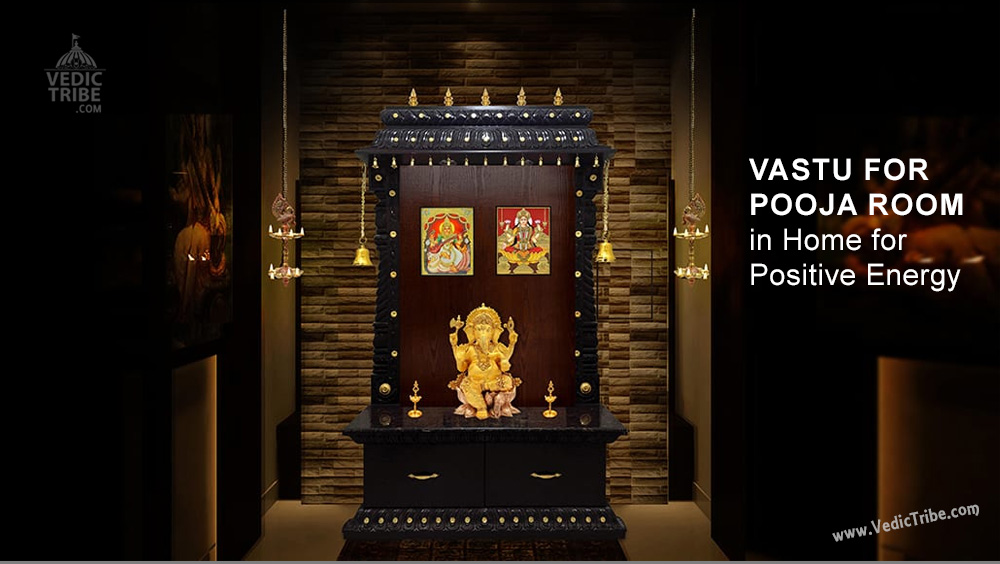
In the present times, Vastu Shastra is the most commonly used term, especially when it comes to purchasing or constructing a new home. To have a happy and prosperous household you must lay stress on enhancing the positive energy inside your home. Vastu Shastra increases wealth, well being and prosperity if you live in structures that allow positive cosmic forces.
One of the most important and sacred corner in any home is a zone of tranquility, the prayer or meditation area; usually known as ‘Pooja Ghar’. Although placement of a Puja Ghar itself brings positive energies in a home, but designing this sacred place as per Vastu guidance enhances positivity in the environment all around. According to Vastu Shastra, the North East zone or the Eeshan (Ishan) corner of a house is the best suited area for placing the Puja room.
It is believed that when Vastu Purush was brought down to the earth, his head laid in the north-east direction. So, while worshipping in this direction along with coming closer to the deity, we also pay obeisance to him. The direction also receives the purifying rays of the rising sun, which purifies the environment and brings positivity and prosperity into our homes.
Follow the below mentioned attributes in order to get an ideal Puja room:
- Never locate the Puja room in the south and the south-east, as these directions are ruled by Yama and Agni, respectively.
- Never locate the Puja space in the bedroom, as this place is for rest and pleasure. However if there is no choice, locate it in the north-east corner of the room. Take care that your feet do not point towards this corner while lying on the bed.
- Avoid locating the toilet above, below or opposite to this room to prevent the negative energies of the toilet from spoiling the auspicious atmosphere of the Puja room.
- This room should also not be constructed next to the kitchen or located under a staircase. In case you do make the Puja space in the kitchen, keep the deity in such a way that you face east while praying.
- In very big plots, factories or apartments, the prayer room can be located in the centre or the Brahmasthana, the sector governed by Lord Brahma, the Creator.
- Make the roof of the Puja room dome or pyramid-shaped. This facilitates smooth flow of positive energies from the tip to the dome or pyramid into the puja room. This shape also assists in meditation.
- Use tranquil colours on the walls of the Puja room like white, soft shades of yellow, blue or violet. These colours do not distract while praying.
- Ideally, the doors and windows of this room should open towards the east or north. These should be made of good quality wood and have double shutters.
- Although north-east is generally the direction recommended for locating the idols or pictures of various Gods; yet different deities have different auspicious locations as described:
- Brahma, Vishnu, Mahesh, Kartikeya, Indra and Surya are placed in the east and facing towards west.
- Ganesh, Durga, Kuber, Shodas Matrika and Bhairav in the north direction and facing south.
- Hanuman in the north-east facing south-west, but never in the south-east as it creates fire hazard.
- Never keep idols brought from ancient temples in the puja room. Also avoid Shrichakra and Shaligram idols, unless you have tremendous spiritual control and are capable of performing puja in a traditional manner.
- Never display photographs of the dead family members along with the deities.
- The height of idols should not be more than 18 inches and should always be placed on a high platform or singhasan.
- Keep the holy books or dharmic granths and other items of samagri and dresses of the deities along the west and south wall.
- The lamp or deepak should be placed in the south-east direction, governed by Agni.
- The Puja room should not be used for other purposes, like storing items that do not belong here. It should also not be used for sleeping purposes or to conceal money and other valuables.
- Never keep a dustbin in the Puja room, as the positive energy gets diminished due to the negative energies emitted by it.
- If you ensure the above mentioned points, you would not only add to the serenity of the room, but would also find yourself spiritually uplifted with increased powers of meditation.
- Dr. Prem Kumar Sharma, resident astrologer of Hindustan Times and Vastu consultant, has authored many books including ‘A Comprehensive Book on Vastu’ and ‘Cultivate Your Relationship the Vastu Way’.
~ By Astrologer Dr. Prem Kumar Sharma
Follow us on Facebook
Follow us on Twitter
Latest


Seven Vows and Steps (pheras) of Hindu Wedding explained
Views: 7,633 Indian marriages are well renowned around the world for all the rituals and events forming part of the...


Sari or Saree is symbol of Indian feminism and culture
Views: 6,462 One of the most sensual attires of a woman in India is undoubtedly the sari. It is a...


Atithi Devo Bhava meaning in Hinduism and India
Views: 5,804 Atithi Devo Bhava, an ancient line taken from the Hindu scriptures and was originally coined to depict a visiting person whose...


Sanskrit Is More Than Just A Method To Communicate
Views: 4,702 -By Ojaswita Krishnaa Chaturvedi anskrit is the language of ancient India, the earliest compilation of sound, syllables and...


Significance of Baisakhi / Vaisakhi
Views: 5,852 Baiskhi is also spelled ‘Vaisakhi’, and is a vibrant Festival considered to be an extremely important festival in...


Navaratri: The Nine Divine Nights of Maa Durga!
Views: 6,879 – Shri Gyan Rajhans Navratri or the nine holy days are auspicious days of the lunar calendar according...


History of Vastu Shastra
Views: 9,498 Vastu Shastra (or short just Vastu) is the Indian science of space and architecture and how we may...


Significance of Bilva Leaf – Why is it dear to Lord shiva?
Views: 9,068 – Arun Gopinath Hindus believe that the knowledge of medicinal plants is older than history itself, that it...


Concept of Time and Creation (‘Brahma Srishti’) in Padma Purana
Views: 9,480 Pulastya Maha Muni affirmed to Bhishma that Brahma was Narayana Himself and that in reality he was Eternal....


Karma Yoga – Yog Through Selfless Actions
Views: 8,745 Karma Yoga is Meditation in Action: “Karma” means action and “yoga” means loving unity of our mind with...




